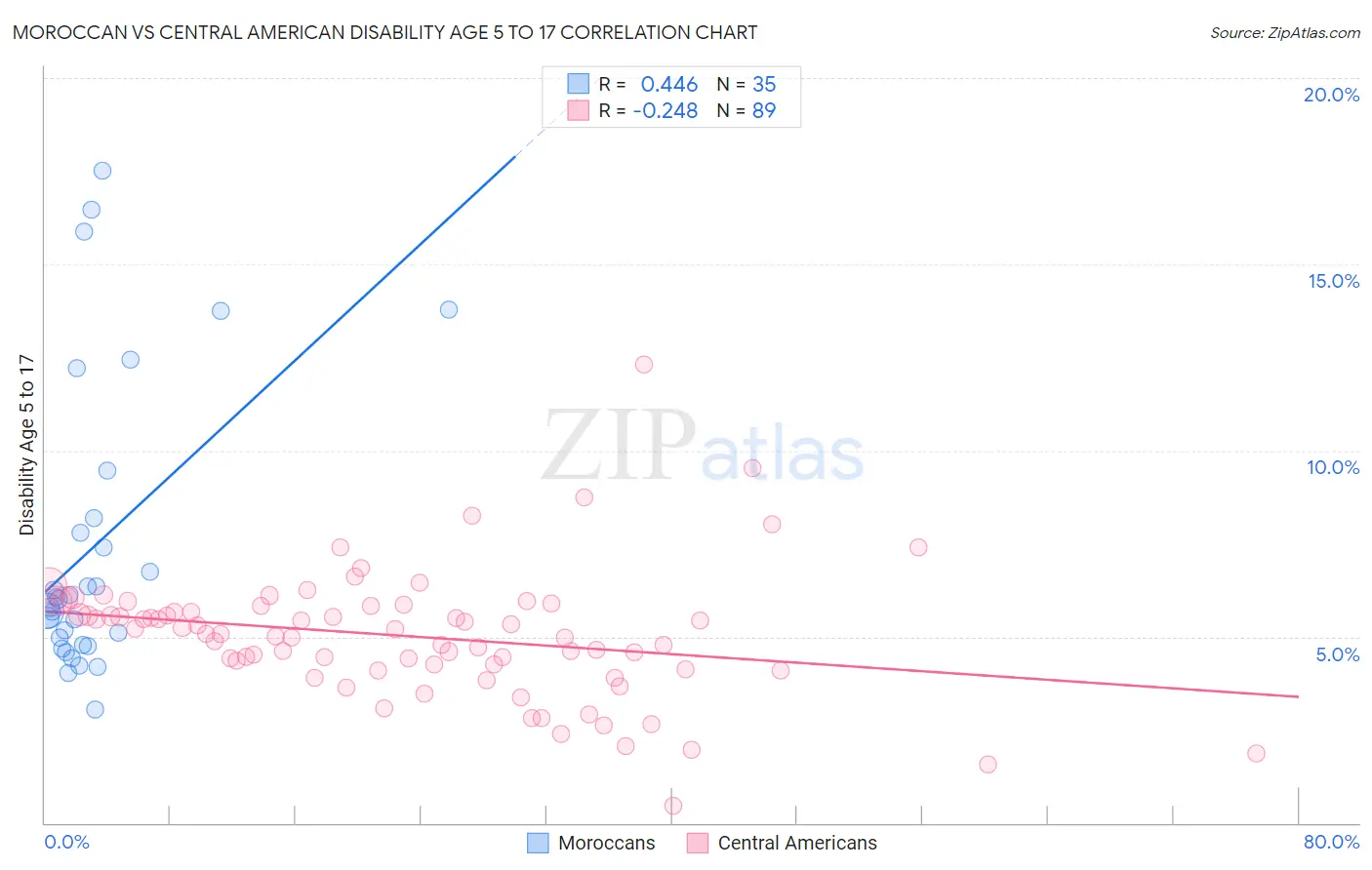Moroccan vs Central American Disability Age 5 to 17
COMPARE
Moroccan
Central American
Disability Age 5 to 17
Disability Age 5 to 17 Comparison
Moroccans
Central Americans
5.7%
DISABILITY AGE 5 TO 17
10.4/ 100
METRIC RATING
207th/ 347
METRIC RANK
5.5%
DISABILITY AGE 5 TO 17
81.6/ 100
METRIC RATING
149th/ 347
METRIC RANK
Moroccan vs Central American Disability Age 5 to 17 Correlation Chart
The statistical analysis conducted on geographies consisting of 201,086,973 people shows a moderate positive correlation between the proportion of Moroccans and percentage of population with a disability between the ages 5 and 17 in the United States with a correlation coefficient (R) of 0.446 and weighted average of 5.7%. Similarly, the statistical analysis conducted on geographies consisting of 498,564,023 people shows a weak negative correlation between the proportion of Central Americans and percentage of population with a disability between the ages 5 and 17 in the United States with a correlation coefficient (R) of -0.248 and weighted average of 5.5%, a difference of 4.6%.

Disability Age 5 to 17 Correlation Summary
| Measurement | Moroccan | Central American |
| Minimum | 3.0% | 0.47% |
| Maximum | 17.5% | 12.3% |
| Range | 14.5% | 11.8% |
| Mean | 7.5% | 5.0% |
| Median | 6.0% | 5.1% |
| Interquartile 25% (IQ1) | 4.8% | 4.2% |
| Interquartile 75% (IQ3) | 8.2% | 5.8% |
| Interquartile Range (IQR) | 3.4% | 1.6% |
| Standard Deviation (Sample) | 3.9% | 1.7% |
| Standard Deviation (Population) | 3.9% | 1.7% |
Similar Demographics by Disability Age 5 to 17
Demographics Similar to Moroccans by Disability Age 5 to 17
In terms of disability age 5 to 17, the demographic groups most similar to Moroccans are Trinidadian and Tobagonian (5.7%, a difference of 0.050%), Immigrants from Africa (5.7%, a difference of 0.050%), Kenyan (5.8%, a difference of 0.050%), Immigrants from Uganda (5.8%, a difference of 0.090%), and Paiute (5.7%, a difference of 0.10%).
| Demographics | Rating | Rank | Disability Age 5 to 17 |
| Icelanders | 14.6 /100 | #200 | Poor 5.7% |
| Basques | 13.7 /100 | #201 | Poor 5.7% |
| Austrians | 13.2 /100 | #202 | Poor 5.7% |
| Spanish American Indians | 12.8 /100 | #203 | Poor 5.7% |
| Paiute | 11.2 /100 | #204 | Poor 5.7% |
| Trinidadians and Tobagonians | 10.8 /100 | #205 | Poor 5.7% |
| Immigrants | Africa | 10.8 /100 | #206 | Poor 5.7% |
| Moroccans | 10.4 /100 | #207 | Poor 5.7% |
| Kenyans | 10.0 /100 | #208 | Poor 5.8% |
| Immigrants | Uganda | 9.7 /100 | #209 | Tragic 5.8% |
| Immigrants | Haiti | 9.5 /100 | #210 | Tragic 5.8% |
| Yugoslavians | 9.1 /100 | #211 | Tragic 5.8% |
| Immigrants | Panama | 8.7 /100 | #212 | Tragic 5.8% |
| Immigrants | Cameroon | 8.3 /100 | #213 | Tragic 5.8% |
| Immigrants | Morocco | 8.3 /100 | #214 | Tragic 5.8% |
Demographics Similar to Central Americans by Disability Age 5 to 17
In terms of disability age 5 to 17, the demographic groups most similar to Central Americans are Guatemalan (5.5%, a difference of 0.0%), Samoan (5.5%, a difference of 0.030%), Estonian (5.5%, a difference of 0.070%), Ute (5.5%, a difference of 0.080%), and Immigrants from Albania (5.5%, a difference of 0.13%).
| Demographics | Rating | Rank | Disability Age 5 to 17 |
| Colombians | 88.0 /100 | #142 | Excellent 5.5% |
| Immigrants | Hungary | 87.9 /100 | #143 | Excellent 5.5% |
| Pakistanis | 87.3 /100 | #144 | Excellent 5.5% |
| Immigrants | Guatemala | 86.6 /100 | #145 | Excellent 5.5% |
| Albanians | 83.7 /100 | #146 | Excellent 5.5% |
| Immigrants | Albania | 83.1 /100 | #147 | Excellent 5.5% |
| Samoans | 81.9 /100 | #148 | Excellent 5.5% |
| Central Americans | 81.6 /100 | #149 | Excellent 5.5% |
| Guatemalans | 81.5 /100 | #150 | Excellent 5.5% |
| Estonians | 80.8 /100 | #151 | Excellent 5.5% |
| Ute | 80.6 /100 | #152 | Excellent 5.5% |
| Ecuadorians | 79.7 /100 | #153 | Good 5.5% |
| Australians | 78.8 /100 | #154 | Good 5.5% |
| Immigrants | Ecuador | 78.3 /100 | #155 | Good 5.5% |
| Hawaiians | 78.0 /100 | #156 | Good 5.5% |